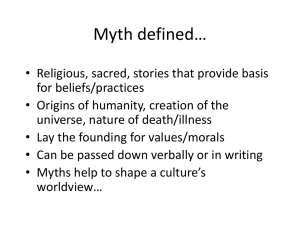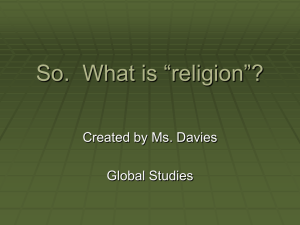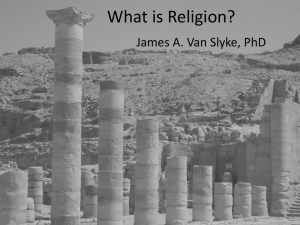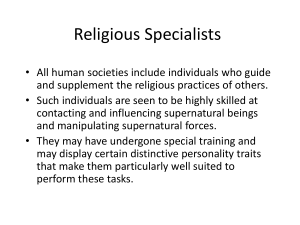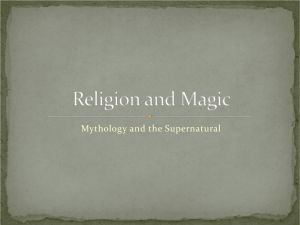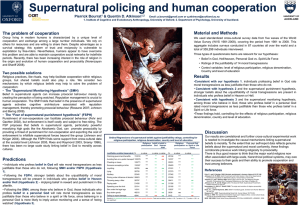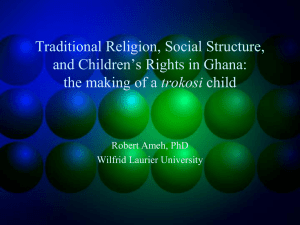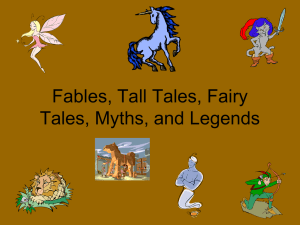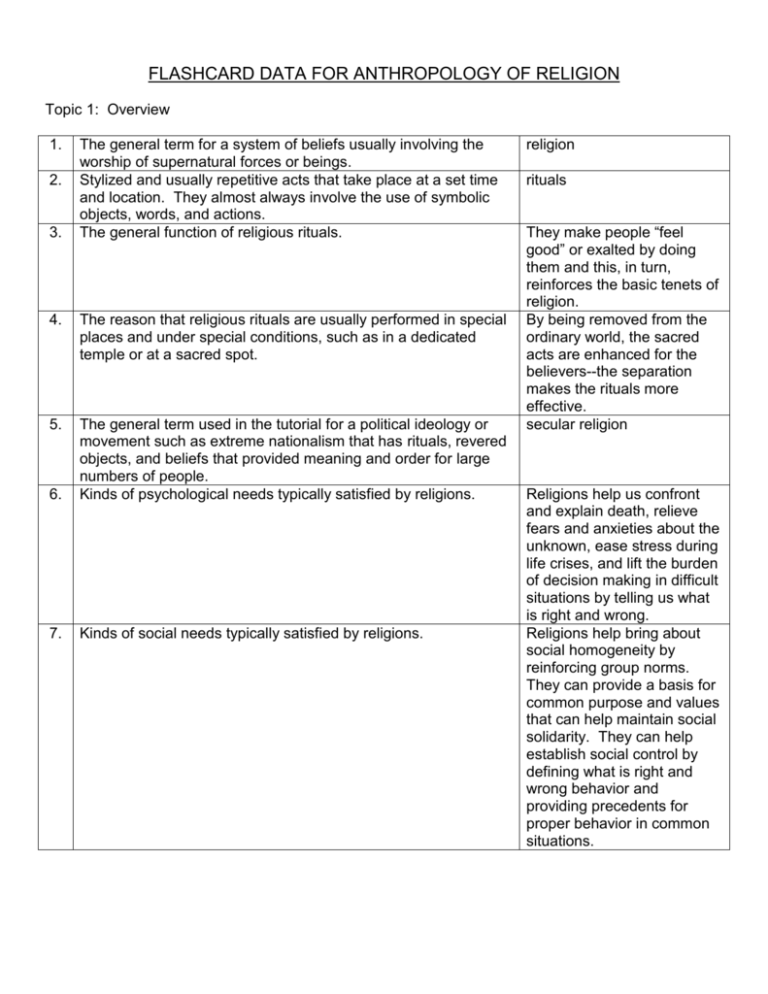
FLASHCARD DATA FOR ANTHROPOLOGY OF RELIGION
Topic 1: Overview
1.
2.
3.
The general term for a system of beliefs usually involving the
worship of supernatural forces or beings.
Stylized and usually repetitive acts that take place at a set time
and location. They almost always involve the use of symbolic
objects, words, and actions.
The general function of religious rituals.
4.
The reason that religious rituals are usually performed in special
places and under special conditions, such as in a dedicated
temple or at a sacred spot.
5.
6.
The general term used in the tutorial for a political ideology or
movement such as extreme nationalism that has rituals, revered
objects, and beliefs that provided meaning and order for large
numbers of people.
Kinds of psychological needs typically satisfied by religions.
7.
Kinds of social needs typically satisfied by religions.
religion
rituals
They make people “feel
good” or exalted by doing
them and this, in turn,
reinforces the basic tenets of
religion.
By being removed from the
ordinary world, the sacred
acts are enhanced for the
believers--the separation
makes the rituals more
effective.
secular religion
Religions help us confront
and explain death, relieve
fears and anxieties about the
unknown, ease stress during
life crises, and lift the burden
of decision making in difficult
situations by telling us what
is right and wrong.
Religions help bring about
social homogeneity by
reinforcing group norms.
They can provide a basis for
common purpose and values
that can help maintain social
solidarity. They can help
establish social control by
defining what is right and
wrong behavior and
providing precedents for
proper behavior in common
situations.
Topic 2: Common Elements of Religion
1.
2.
3.
4.
5.
6.
7.
8.
The general term for a belief in a supernatural power not part of
supernatural beings. For those who hold this belief, the power is
usually impersonal, unseen, and potentially everywhere. It is
neither good nor evil, but it is powerful and dangerous if
misused.
The general term for a belief that natural objects are animated by
spirits. This belief can take diverse forms. Things in nature may
all have within them different spirits--each rock, tree, and cloud
may have its own unique spirit. In contrast, all things in nature
may be thought of as having the same spirit. In both forms of
this belief, the spirits are thought of as having identifiable
personalities and other characteristics such as gender.
The general term for souls or ghost of an ancestor. These spirits
are often seen as retaining an active interest and even
membership in their family and society.
The general term of a powerful supernatural being with an
individual identity and recognizable attributes. These beings
have individual identities and recognizable attributes. They are
more powerful than spirits and other lesser supernatural beings-they can effectively alter all of nature and human fortunes. As a
result, they are commonly worshipped and requests are made of
them to help in times of need. (Hint: another term for such a
being is a deity.)
The general term for a supernatural being who is not a spirit,
god, human, or other natural being. These beings usually have
a human-like appearance and/or personality but can do things
that are beyond the abilities of humans. They often have a
"trickster" role--they fool people, do outlandish things, and
disappear.
"The force" in the Star Wars movies fits the description of this
type of supernatural belief. It is a supernatural force that is
neither good nor evil, but it is powerful and dangerous if
misused.
"Mana" in Polynesian cultures of the South Pacific fits the
description of this type of supernatural belief. (Hint: for the
Polynesians, “mana” was a force inherent in all objects, plants,
and animals (including people) to different degrees. Some
things or people were thought to have more of it than others and
were, therefore, potentially dangerous.)
A belief in a powerful, mature, protective "mother nature" as a
spirit being inherent in all objects, plants, and animals is an
example of this kind of belief. (Hint: this was a common belief in
Native American cultures.)
animatism
animism
ancestral spirit
god or goddess
minor supernatural being
animatism
animatism
animism
9.
10.
11.
12.
13.
14.
15.
16.
17.
18.
A belief in these supernatural beings is consistent with the
widespread idea that humans have at least two parts--a physical
body and some kind of non-physical spirit. The spirit portion is
generally believed to be freed from the body by death and
continues to exist as a supernatural being.
Leprechauns, elves, and pixies in European folk traditions are
this kind of supernatural being.
In Western North American Indian cultures, coyote was often
thought of as this kind of supernatural being. (Hint: these beings
often played a "trickster" role in stories--they fooled people, did
outlandish things, and disappeared.)
The region of the world where ancestral spirits are usually
thought of as still being active family members. They are treated
warmly with respect and honor so that they will want to help their
living descendants.
The region of the world where the dead and their spirits have
been seen historically as dangerous--they haunt the living and
often do unpleasant, frightening, and unpredictable things.
A belief that there is only one god. Judaism, Christianity, and
Islam are usually considered to be this kind of religion.
A belief in more than one god. Hinduism is usually considered to
be this kind of religion.
The term for a supreme god who established the order of the
universe and is now remote from earthly concerns. (Hint: the
term is Greek for "at rest”.)
A kind of a god who is usually almost ignored in favor of lesser
gods who take an interest in the everyday affairs of humans.
(Hint: this kind of god is often seen as the creator of all things but
he/she is now little concerned with things on earth.)
A kind of supernatural being who has less power than a god or
goddess. It may be a dead ancestor or a being that inhabits a
natural object. A belief in these beings is the central tenet of
animism.
ancestral spirits
minor supernatural being
minor supernatural being
China and elsewhere in East
Asia
Europe and European
derived cultures
monotheism
polytheism
otiose (as in otiose deity)
otiose deity
spirit
Topic 3: Religious Leaders
1.
2.
A kind of religious leader who is part of an organized religion.
They are the keepers of the sacred law and tradition. Different
religions have different terms for these individuals--they may be
known as rabbis, ministers, mullahs, Imams, or other
terms. They are found mostly in large-scale societies.
A kind of religious leader who is not part of an organized religion
and is in direct contact with the spirit world, usually through a
trance state. Spirit helpers are at his or her command to carry
out curing, divining, and bewitching.
priest or priestess
shaman
3.
How a shaman usually acquires his/her knowledge and power.
4.
The term for an individual who receives divine revelation
concerning a restructuring of religious practices and usually of
society as well. This type of religious leader calls for dramatic
change in society saying that it is the will of the supernatural
being(s).
The usual attitude of priesthoods towards prophets.
5.
6.
7.
8.
9.
The kind of religious leaders who personally do not have
supernatural powers at their command, but they are authorized
by their religious organization to perform religious rituals
designed to influence the supernatural world and to guide the
believers in their religious practices.
The general term for a magical procedure by which the cause of
a particular event or the future is determined.
The general term for using magical acts and/or the assistance of
supernatural beings to cause something to occur.
Techniques commonly used by shamans and others to enter an
altered state of consciousness.
Shamans most often acquire
it individually, usually in
physical and/or mental
isolation from other humans.
Spirits are revealed and
he/she learns how to control
them. Older shamans help
in learning how to use the
knowledge and power.
prophet
Priests generally consider
prophets to be disruptive
trouble-makers because
priests are the keepers of
religious traditions while
prophets demand that those
traditions be abandoned or
radically changed.
priests
divination
bewitching
fasting, self-torture, sensory
deprivation, breathing
exercises and meditation,
prolonged repetitive ritual
dancing and/or drumming,
and hallucinogenic drugs
shaman
10. The kind of religious leader who is essentially a religious
entrepreneur acting for human clients. He/she intervenes on
behalf of a human client to influence supernatural beings to
perform some act such as curing an illness or discovering the
cause of an unexpected death. This kind of religious leader
essentially acts as a middleman in this.
11. The kind of religious leader who tells people what to do to appeal priest
to the supernatural being(s) instead of telling the supernatural
beings what to do. This leader has knowledge but does not
have supernatural power.
12. The kinds of societies in which shamans are most common.
small-scale societies
(Hint: think in terms of small-scale and large-scale societies.)
13. The kinds of societies in which priests are most common. (Hint: large-scale societies
think in terms of small-scale and large-scale societies.)
14. Joseph Smith, the founder of the Church of the Latter Day Saints prophet
(the Mormons), was this kind of religious leader. (Hint: he had
divine revelations that led him to create the L.D.S. religious
movement in the 1830's and early 1840's. Think in terms of
priests, shamans, and prophets.)
15. People in the Philippines and in some American Philippine
shaman
communities who perform "spirit surgery" are this kind of
religious leader. (Hint: Think in terms of priests, shamans, and
prophets.)
Topic 4: Trancing in Religion
1.
2.
3.
4.
5.
Common techniques used by shamans to achieve a trance state. fasting, self-torture, sensory
deprivation, breathing
exercises and meditation,
prolonged repetitive ritual
dancing and/or drumming,
and hallucinogenic drugs
What shamans commonly report that they do when they go into
They are taking a journey in
a trance.
which they must pass
through difficult situations in
order to reach their own spirit
helpers. Those friendly
spirits then aid the shaman in
curing an illness, bewitching
someone, or in some other
supernatural way.
The general term for a mind altering drug that can cause
hallucinogen (or
profound hallucinations or an altered state of awareness.
hallucinogenic drug)
The area of the world where shamanistic use of mind altering
Native America, especially in
drugs has been especially widespread.
small-scale, egalitarian
societies in the Amazon
Basin and Mesoamerica
The source of most mind altering drugs used for religious
plants
purposes by shamans. (Hint: think in terms of plants, animals,
minerals, etc.)
Topic 5: Magic and Religion
1.
The general term for the use of ritual formulas to compel or
influence supernatural beings or powers to act in certain ways
for good or evil purposes.
magic
2.
3.
4.
5.
6.
The general term for magic based on the principle that "like
produces like." For instance, whatever happens to an image of
someone will also happen to them. (Hint: this is also referred to
as "imitative" magic.)
The general term for magic that is based on the principle that
things or persons once in contact can afterward influence each
other. In other words, there is a permanent relationship between
an individual and any part of his or her body.
The principle of magic involved in the use of voodoo dolls in the
folk tradition of Haiti.
The principle of magic involved when people must take special
precautions with their hair, fingernails, teeth, clothes, and feces
because someone could use these things to perform magic
which would cause the person they came from to be affected.
The reason that the existence of witchcraft cannot be easily
refuted with arguments based on scientific facts.
7.
The method used by ancient Romans to divine the future.
8.
The method commonly used by shamans to divine the future.
9.
The way mental illness is usually explained in societies which
accept that magic and witchcraft are real.
10. How witchcraft can be used as a means of social control in a
society that strongly believes in its practice and power.
11. The general term for actions involving magic or supernatural
powers usually undertaken for the purpose of doing harm. (Hint:
this is a limited anthropological definition that does not describe
the activities of modern Western European and North American
Wicca. The latter are members of an organized religion.)
Copyright © 2004 by Dennis O'Neil. All rights reserved.
sympathetic magic
contagious magic
sympathetic magic
contagious magic
Believers are not dissuaded
by pointing out that there is
no evidence that any
witchcraft was used against
them because it can be
practiced in secret.
autopsying chickens and
examining the condition of
their livers
entering a trance state to find
out the answers from their
spirit helpers
It is seen as being a
consequence of witchcraft or
the actions of supernatural
beings and forces.
Deviant behavior often
results in an individual being
labeled as a witch. Since
witches are feared and often
ostracized or even killed
when discovered, the mere
threat of being accused of
witchcraft can be sufficient to
force people into modal
behavior.
witchcraft

